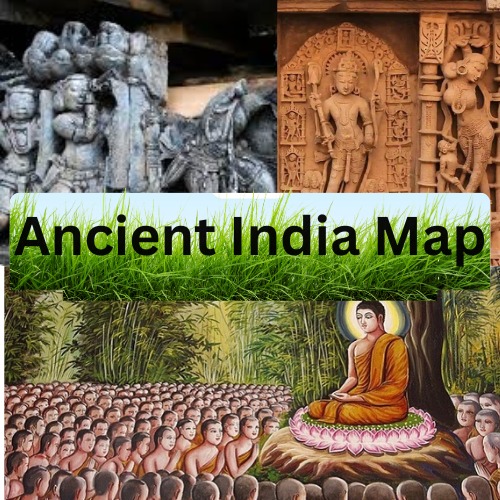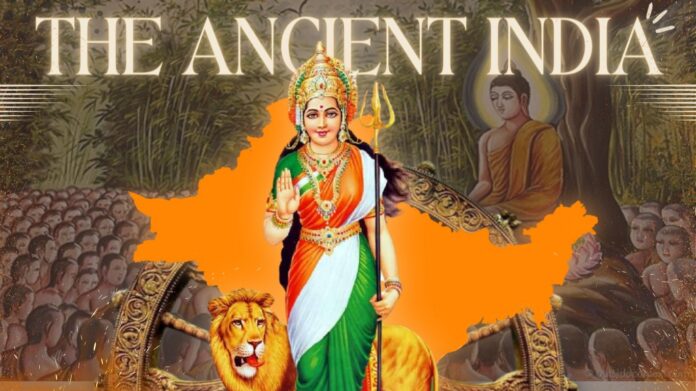Ancient India map is a tapestry woven with threads of time, culture, and civilization, each layer adding depth to its historical landscape. Spanning millennia, its boundaries ebbed and flowed, shaped by conquests, migrations, and cultural exchanges.
From the earliest settlements along the banks of the Indus and Ganges rivers to the vast empires that rose and fell, the map of ancient India reflects the dynamic interplay between geography and human endeavor.
The earliest maps of ancient India were likely mental constructs, drawn in the minds of early inhabitants to navigate their surroundings and understand their place in the world. These maps would have been rudimentary, based on landmarks, rivers, and natural features.
As settlements grew into cities and trade routes expanded, the need for more accurate maps became apparent.

One of the earliest known maps of India is the Harappan seal, dating back to the Indus Valley Civilization (circa 2600–1900 BCE) The Ancient India map. This intricate seal depicts a mythical creature, possibly a unicorn, alongside symbols that may represent early settlements or trade routes.
While limited in geographical detail, it provides valuable insights into the worldview of ancient Indians and their connection to the natural world.
The Ancient India Map The Vedic period (circa 1500–500 BCE) saw the emergence of the earliest literary sources mentioning geographical features of India.
The Rigveda, one of the oldest sacred texts of Hinduism, contains hymns describing rivers such as the Sindhu (Indus) and the Sarasvati, as well as references to the sacred geography of the Indian subcontinent.
These hymns not only serve as religious texts but also as early attempts to map and understand the landscape of ancient India.
The Ancient India Map, The Mauryan Empire (circa 322–185 BCE) marked a significant milestone in the cartography of ancient India. Under the reign of Emperor Ashoka, the empire expanded to encompass a vast territory, stretching from present-day Afghanistan to Bangladesh.
Ashoka’s edicts, inscribed on pillars and rocks throughout the empire, provide valuable insights into the administrative divisions and geographical extent of his realm. These inscriptions, written in Prakrit, Greek, Aramaic, and other languages, served to spread knowledge about the Mauryan Empire both within and beyond its borders.
During the Ancient India Map The Gupta Empire (circa 320–550 CE), known as the Golden Age of India, the arts, sciences, and scholarship flourished. The Gupta period saw advancements in mathematics, astronomy, and cartography.
The mathematician and astronomer Aryabhata, in his treatise Aryabhatiya, described the earth as a sphere and calculated its circumference with remarkable accuracy. While Aryabhata’s work focused more on theoretical astronomy, it laid the foundation for future cartographic endeavors in India.
The medieval period witnessed the rise of Islamic empires in India, such as the Delhi Sultanate and the Mughal Empire. These empires brought new cultural influences and administrative practices to the subcontinent.
The Mughal emperor Akbar (Ancient India map) , in particular, was known for his interest in cartography and commissioned several maps of India during his reign. These maps, produced by Mughal court cartographers, combined indigenous knowledge with Persian and European cartographic techniques.
European colonization of India ( Ancient India map) in the 16th century brought about a new chapter in the mapping of the subcontinent. Portuguese, Dutch, French, and British traders and explorers produced maps of India for navigation, trade, and territorial control.
The British East India Company, in its quest for territorial expansion, conducted extensive surveys and mapping projects across India. The Great Trigonometrical Survey, initiated in the early 19th century, aimed to accurately map the entire Indian subcontinent using trigonometric methods.
In conclusion, Ancient India Map of ancient India is a palimpsest, bearing the imprints of countless civilizations, cultures, and peoples who have called the subcontinent home.
From the Ancient India map the Indus Valley Civilization to the Mauryan Empire, from the Gupta Golden Age to the Mughal Renaissance, each era has left its mark on the geographical and cultural landscape of India.
Through literary texts, inscriptions, and cartographic endeavors, ancient Indians sought to understand and navigate their world, leaving behind a rich legacy of knowledge and exploration of the Ancient India map.
What are some of the earliest known maps of ancient India?
One of the earliest known maps is the Harappan seal from the Indus Valley Civilization (circa 2600–1900 BCE), depicting a mythical creature alongside symbols possibly representing early settlements or trade routes.
How did ancient Indians navigate their surroundings before the advent of maps?
Before the development of maps, ancient Indians likely relied on mental constructs based on landmarks, rivers, and natural features to navigate their surroundings.
How did the Vedic period contribute to the understanding of ancient Indian geography?
The Vedic period (circa 1500–500 BCE) saw the emergence of literary sources like the Rigveda, containing hymns describing rivers such as the Indus and the Sarasvati, providing insights into the sacred geography of the Indian subcontinent.
What were some significant advancements in ancient Indian cartography during the Gupta Empire?
The Gupta Empire (circa 320–550 CE) witnessed advancements in mathematics, astronomy, and cartography. Mathematician and astronomer Aryabhata, in his treatise Aryabhatiya, described the earth as a sphere and calculated its circumference with remarkable accuracy.
How did European colonization impact the mapping of ancient India?
European colonization in the 16th century led to extensive surveys and mapping projects in India. European traders and explorers produced maps for navigation, trade, and territorial control, with efforts like the Great Trigonometrical Survey initiated by the British East India Company in the 19th century aimed at accurately mapping the entire subcontinent.




